#Virtualized mobile core
Explore tagged Tumblr posts
Text
The Growing Virtualized Evolved Packet Core (vEPC) Market: Driving Next-Gen Connectivity
The Virtualized Evolved Packet Core (vEPC) Market was valued at USD 8.1 billion in 2023 and will surpass USD 23.5 billion by 2030; growing at a CAGR of 16.4% during 2024 - 2030. At the heart of this transformation is the Evolved Packet Core (EPC), the core network architecture for LTE (Long-Term Evolution) and 4G networks. However, as the demand for data grows and the transition to 5G accelerates, traditional EPC systems are struggling to keep up. Enter the Virtualized Evolved Packet Core (vEPC) – a next-generation solution that is redefining how networks are built and managed.
Understanding vEPC
Virtualized Evolved Packet Core (vEPC) refers to the deployment of EPC functions using Network Functions Virtualization (NFV) technology. In a traditional EPC, network functions like the Serving Gateway (SGW), Packet Data Network Gateway (PGW), and Mobility Management Entity (MME) are implemented on dedicated hardware. In contrast, vEPC decouples these functions from physical hardware, allowing them to run as software instances on standard, off-the-shelf servers in a virtualized environment.
This shift to virtualization brings numerous benefits, including improved flexibility, scalability, and cost-efficiency. By leveraging NFV, service providers can dynamically allocate resources based on demand, scale their networks quickly, and reduce capital and operational expenditures. This makes vEPC an essential component in the evolution towards 5G networks and beyond.
Get a Sample Report: https://intentmarketresearch.com/request-sample/virtualized-evolved-packet-core-vepc-market-3649.html
Market Growth Drivers
The vEPC market is experiencing robust growth, driven by several key factors:
5G Rollout: As 5G networks become more widespread, the need for scalable and flexible core network solutions is paramount. vEPC provides the necessary foundation for 5G by enabling faster deployment, efficient resource utilization, and the ability to support diverse use cases, from enhanced mobile broadband to massive IoT connectivity.
Increased Data Traffic: The exponential growth in mobile data traffic, fueled by video streaming, social media, and IoT applications, is putting immense pressure on traditional network infrastructures. vEPC allows service providers to handle this surge in data traffic more effectively, ensuring seamless connectivity and improved user experiences.
Cost Efficiency: Virtualization reduces the need for expensive, proprietary hardware, enabling service providers to lower their capital and operational expenditures. Additionally, the ability to scale resources up or down based on demand helps in optimizing network costs, making vEPC a more cost-effective solution compared to traditional EPC.
Network Slicing: A key feature of 5G is network slicing, which allows operators to create multiple virtual networks on a single physical infrastructure, each tailored to specific applications or services. vEPC plays a critical role in enabling network slicing by providing the flexibility and agility needed to create and manage these virtual networks efficiently.
Rapid Time-to-Market: In today’s fast-paced environment, the ability to launch new services quickly is crucial for staying competitive. vEPC enables service providers to reduce the time-to-market for new services by streamlining network deployment and management processes.
Market Challenges
While the vEPC market presents significant opportunities, it also faces challenges that could impact its growth:
Interoperability Issues: As vEPC involves integrating various network functions from different vendors, ensuring interoperability can be challenging. Service providers must carefully select compatible solutions to avoid integration issues that could lead to network performance degradation.
Security Concerns: Virtualized environments can be more vulnerable to security threats compared to traditional hardware-based systems. Ensuring robust security measures are in place is critical to protect sensitive data and maintain network integrity.
Skills Gap: The transition to virtualized networks requires new skill sets that may not be readily available within existing telecom teams. Investing in training and upskilling is necessary to fully leverage the benefits of vEPC.
Get an insights of Customization: https://intentmarketresearch.com/ask-for-customization/virtualized-evolved-packet-core-vepc-market-3649.html
The Future of vEPC
Looking ahead, the vEPC market is poised for continued growth as more service providers embrace virtualization and move towards 5G. The flexibility, scalability, and cost-efficiency offered by vEPC will be key to supporting the diverse and demanding use cases of future networks. As the technology matures, we can expect further innovations in areas such as automation, orchestration, and edge computing, all of which will enhance the capabilities of vEPC and drive its adoption.
0 notes
Text
Virtualized Evolved Packet Core Market Projected to Reach $19.87 Billion by 2031
According to the latest publication from Meticulous Research®, the virtualized evolved packet core (vEPC) market is projected to reach $19.87 billion by 2031, growing at a CAGR of 19.3% from 2024 to 2031. This growth is driven by the significant increase in mobile data traffic volumes and the rising demand for high-speed data services. However, data security risks associated with vEPC infrastructure pose challenges to market growth.
#Virtualized Evolved Packet Core Market#VEPC Market#Mobility Management Entity#Home Subscriber Server#Packet Data Network Gateway#Policy and Charging Rules Function#Mobile Private Network & Mobile Virtual Network Operator (MPN & MVNO)#Long-term Evolution & Voice over Long-term Evolution (LTE & VoLTE)#Telecom Operators#Internet of Things & Machine to Machine
0 notes
Text
Sins, Virtues, and Motivations: A Critical Analysis of Characters in Shall We Date?: Obey Me!
In this essay, I will argue that each demon brother some of the demon brothers can be associated with a sin (no duh), a virtue, and a core motivation--and that this motivation is best pursued through a synthesis of that sin and that virtue. Hegel would be very proud. Yes, this is critical media analysis. No, I will not try to explain the twisted, broken path that led me to this point in my life.
I will be looking at Lucifer, Mammon, and Levi in this study. Their core sins are obvious - Pride, Greed, and Envy. Their accompanying Virtues and Motivations are listed below.
I used the Seven Heavenly Virtues for this little game. These are Prudence, Justice, Fortitude, Temperance, Faith, Hope, and Charity.
They should not be confused with the Seven Capital Virtues, which are inversions of the Seven Deadly Sins. These are Humility, Charity, Kindness, Patience, Chastity, Temperance, and Diligence. I tried these first and damn were none of them easy to match up. Tell me, fandom for this mobile game designed for players to lust over hot demon men, which brother should have the "chastity" virtue?
Lucifer
Core Sin: Pride. Core Virtue: Fortitude. Core Motivation: To protect his family.
Lucifer's core motivation is to protect his brothers. He looks at this as a sort of penance for the outcome of the Great Celestial War. He knows that he's the reason they rebelled, and he feels responsible for their wellbeing. He is able to endure the relentless pressure of the responsibilities he puts on himself thanks to his core virtue, fortitude.
Fortitude is strongly associated with courage. Specifically, it is courage in the face of pain and adversity. We see him displaying this trait any time those he cares for are in jeopardy, and it often helps him make difficult decisions where neither outcome is ideal. Lucifer is decisive, canny, and accepts the consequences of his choices, good or bad.
His driving motivation is also bolstered by his core sin: pride. He views himself as ultra-competent, while his brothers consistently make mistakes; beyond that, it's only natural that he take responsibility for the choices of his brothers (like the choice to join him in rebelling) because he is so significant an influence as to virtually rob them of their autonomy.
This has led to Lucifer having a somewhat toxic relationship with his brothers. Lucifer often acts as a parental figure rather than a peer, while the rest of them are all in arrested development of some sort, often acting more like kids than the adults they insist they are.
Lucifer either doesn't recognize that by doing everything for the family on his own, he's stemming their ability to grow and learn, or he does know the consequences of what he's doing and he feels conflicted about it. He ultimately blames himself for the fact that they're all in the Devildom in the first place, living as avatars of sins to the extent that they struggle to function as independent adults.
So, while fortitude and pride allow Lucifer to simulate the act of protecting his family, it's a matter of perspective whether controlling every element of their lives is protection or harmful coddling.
Mammon
Core Sin: Greed. Core Virtue: Charity. Core Motivation: To be valued and valuable.
Mammon is simultaneously a vessel of greed and its inverse, charity. This is because his core motivation is twofold, and those are the rewards of greed and charity; to be valued - to fulfill a want, to be desired, to look flippin' cool - and to be valuable - to fulfill a need, to have inherent worth, to serve a purpose.
Setting aside his unhealthy relationship with money, let's examine how Mammon behaves and what his deeper interpersonal motivations tend to be. He clearly places a high value on his brothers and MC, and he has shown on multiple occasions that he is willing to put himself at risk to help or protect them. Early on in both the original game and in NightBringer, Mammon attempts to heroically rescue MC (and his younger brothers, in NightBringer). In both cases, though, Lucifer shows up and does it for him. Mammon's pursuit of his core motivation clashes with Lucifer's quest for his, and Lucifer is strong enough to simply take it from him. Although in NightBringer he and his brothers do earn the not-insubstantial reward of the title "Lords of the Underworld" after Lucifer's rescue, he appeared so dejected by Lucifer's oneupmanship that he spent a good portion of the next day sulking. In the original game, Mammon wants MC to promise that they won't be saved by anyone else besides him in the future. It appears that his greed for an improved status in his interpersonal relationships is left unfulfilled.
Mammon wants to be heroic - to be valuable - and he wants to be admired for it - to be valued. The cognitive dissonance that accompanies motivations like these is all that sustains a person with such a diminished sense of self-worth.
Speaking of a diminished sense of self worth...
Leviathan
Core Sin: Envy. Core Virtue: Hope. Core Motivation: To find joy in the things that give him joy.
Confusing motivation? Yes it is. But envy is a confusing sin. All the other sins--pride, greed, wrath, lust, gluttony, and sloth--are enjoyable to indulge on some level. Losing your temper when you feel you've been wronged, or eating a bunch of delicious food, or sleeping through the snooze alarm: We know why we do those things. We might regret them later, but we indulge them in the moment because of the enjoyable side.
There is nothing enjoyable about envy. Wanting something that isn't yours, that belongs to someone else, be it tangible goods, talents, a partner, a job... is nauseating. And it makes you feel like a bad person, and it drains the joy out of things that you used to love. Speaking from personal experience for a second, when I was a teenager, I played music in a company with a much younger musician who was incredibly talented, and I was deeply envious of her. I wanted her talent; I wanted the praise she received; I wanted to impress people; I wanted what she had. But there was nothing I could do. I hated feeling that way, but I couldn't shake it. And it ate away at my desire to play music. It took the joy out of something that once gave me joy.
You see the connection?
Levi struggles to find pleasure in anything he does, despite how many interests he has, because, in spite of his blustering dismissal of all things "normie", he is deeply envious of those he perceives as his social superiors. Now, I am not in any way saying that Levi is or would be an inc3l, but there's an element of his character that has a strong parallel to inc3l culture. The idea that there is something fundamentally wrong with him that prevents him from achieving what he wants socially and that the only way he can protect himself from those who would ridicule him is with a defensive contempt for the group that rejects him... Does any of that sound familiar?
But Levi is not an inc3l. No, not because you're willing to **** him and his two *****, though I'm sure that helps. It's because he has his core virtue: hope.
Have you ever heard of the black pill? It's kind of like the final stage of inc3l culture, where you accept that you're not an alpha male, you'll never be one, you'll never be accepted by a woman, you're ugly and unloveable, and you might as well just stop existing. It is sheer despair.
Levi maintains hope for the future, even if he prefers not to admit it out of fear of jinxing himself. He is able to form a deep bond with MC, who he views as a "normie", without renouncing his hobbies or being mocked for them. In fact, I would argue that the anxiety Levi sometimes displays over the possibility of being made fun of (for example, in NightBringer when he considers trying out cosplay) is emblematic of the hope he has that he can be accepted.
"But wait, daytaker," you say. "That doesn't sound like he's making progress towards his core motivation of getting joy out of the things that bring him joy! Being self conscious is not joyful!" Well, you're right. What Levi needs is to somehow find the right balance between enjoying his hobbies and allowing himself to enjoy other people as well. As we can see from his effusive excitement in sharing his favorite games and stories with MC and his brothers, the social component of media consumption is a major component in making it enjoyable. If Levi loses hope, he loses that connection to the world offline, and if he loses that connection, he loses the joy.
@blackstqr (I did it.)
#obey me#obey me leviathan#dthc#obey me luficer#obey me mammon#long form#jesus fucking christ#i censored inc3l just to avoid being searched by any undesirables#starts out like an academic paper and ends like me drinking a beer and pointing at my phone#wow guys it's so deep#obey me headcanons#obey me scholarship#obey me nightbringer#text post#hc#hcs#lucifer#mammon#levi#is this satire? i don't even know anymore#i almost did satan too but i got like 3 sentences in and said nope#levi thoughts#mammon thoughts#lucifer thoughts
148 notes
·
View notes
Text
Transform Your Tomorrow with Zylentrix: Sustainable Innovation for Businesses, Careers, and Global Growth
🌐 Zylentrix: Redefining Success Through People-Centric Solutions
At Zylentrix, we’re on a mission to empower individuals, businesses, and communities through innovation, integrity, and sustainability. Our vision? To lead the world in integrated consultancy services, transforming challenges into stepping stones for growth. Whether you’re scaling a business, launching a career, or pursuing education, we’re here to equip you with the tools to thrive. Let’s unpack how our mission, values, and culture make us the partner you can trust.
🎯 Our Mission & Vision: The North Star of Zylentrix
Mission: “To empower individuals, businesses, and communities by delivering innovative and customised solutions across education, technology, recruitment, and business consulting. With a commitment to excellence, integrity, and sustainability, we strive to create opportunities, bridge gaps, drive transformation, and foster long-term success.”
Vision: “To be the global leader in integrated consultancy services, transforming lives and businesses through innovative, sustainable, and forward-thinking solutions that empower individuals, businesses, and communities to thrive and succeed.”
We’re not just consultants—we’re architects of progress, designing futures where everyone has the chance to excel.
💎 Core Values: The Pillars of Everything We Do
Our values are the blueprint for how we serve clients, collaborate with partners, and grow as a team:
Integrity: “Building Trust Through Transparency” Every decision is guided by ethics. No shortcuts, no compromises.
Innovation: “Driving Future-Ready Solutions” From AI-driven recruitment tools to sustainable business frameworks, we pioneer what’s next.
Excellence: “Delivering Impact & Measurable Growth” We set—and smash—high standards, ensuring clients see real results.
Customer-Centricity: “Putting Clients at the Centre of Everything” Your goals shape our strategies. We listen, adapt, and deliver.
Diversity, Inclusion & Collaboration: “Creating Equal Opportunities for All” Diverse teams = smarter solutions. We champion equity in every project.
Sustainability: “Responsible Business for a Better Future” Green tech, eco-friendly practices, and ethical growth are non-negotiables.
Empowerment: “Enabling People & Businesses to Thrive” We don’t just hand you tools—we teach you how to master them.
🤝 Our Commitment: Tailored Support for Every Journey
Zylentrix is your partner in growth, no matter your starting point:
For Businesses:
Tech Solutions: Streamline operations with scalable AI, cybersecurity, and cloud systems.
Strategic Recruitment: Access global talent pools curated for cultural and technical fit.
Consulting Excellence: Turn insights into action with market research and digital transformation plans.
For Job Seekers:
Career Mastery: Revamp resumes, ace interviews, and unlock roles in booming industries like fintech and clean energy.
Global Mobility: Navigate international job markets with visa support and relocation guidance.
For Students:
Education Pathways: Secure admissions and scholarships at top universities worldwide.
Future-Proof Skills: Gain certifications in AI, sustainability, and more through our partnerships.
For Startups & SMEs:
Scale Smart: Leverage data analytics and ESG frameworks to grow responsibly.
Funding Ready: Craft investor pitches that stand out in crowded markets.
🌱 Our Culture: Fueling Innovation from Within
At Zylentrix, our workplace is a launchpad for creativity and collaboration. Here’s what defines us:
Lifelong Learning: Monthly workshops, innovation challenges, and tuition reimbursements keep our team ahead of trends.
Agility in Action: When the world changes, we pivot faster—like shifting to virtual career fairs during the pandemic.
Collaborative Spirit: Cross-departmental “sprint teams” solve client challenges, blending tech experts, educators, and recruiters.
Ownership & Impact: Every employee, from interns to executives, contributes to client success stories.
Work-Life Harmony: Flexible hours, mental health resources, and sustainability days ensure our team thrives inside and out.
Join the Zylentrix Movement
Ready to transform your business, career, or community? Let’s build a future where innovation and integrity go hand in hand.
📩 Connect Today 👉 Explore our services: Zylentrix 👉 Follow us on Social Media for tips on tech, careers, and sustainability. LinkedIn Facebook Instagram TikTok X Pinterest YouTube Quora Medium 👉 Email [email protected] to schedule a free consultation.

27 notes
·
View notes
Text
I've been watching Vrains for the first time, and I finished season 1
some thoughts below (a lot. a lot of thoughts below)
Setting & Setup
The setting is a very smart choice, and the highlight of Vrains in my opinion.
The aesthetic is relevant, it integrates well with Konami marketing its mobile games, and it neatly deals with the problem every Yugioh series has to address of how to make consequences for duels that can be safely broadcast on children's television (aka the shadow realm / sent to the stars problem)
The virtual world opens up so much possibility in how to present things.
In the character and setting designs, obviously, but also, the duels have their own visual identity. They don't need to play cards on a duel disk or hold cards in their hand, cards will just appear and disappear in pixels (it also probably saves on their animation budget). The duel grid and other visualizations can show up as they're relevant. And seeing the character take gashes to their avatars is dramatic while still being kid-friendly.
Every Yugioh needs its peanut gallery to react to the duel and be explained to, and Vrains incorporates them the most easily of any series, since they don't need to be physically present.
Kill the frog and the pigeon though.
On the topic of duels, I like both link summoning and speed duels.
I like the spacial/positioning element of link summoning, it puts an additional layer on top of "little monsters make big monster."
And speed duels have all the advantages of turbo duels, allowing for dynamic action, visual metaphor for the tide of the duel, and the ability to change locations without sacrificing pacing, all while requiring less suspension of disbelief than card games on motorcycles. It's easy to take for granted, but the heist sequences wouldn't work at all if they had to be standing duels.
I also liked this about season 1 of 5Ds, where there's two modes of dueling (turbo duels and ground duels). The contrast between speed duels and master duels is fun.
Skills are cool too, though I feel like they could have designed better ones. Seeing Yusaku drop below 1000 got kind of predictable.
And finally, there is rich thematic potential in this kind of virtual setting. Themes about our relationship with social media, video games, artificial intelligence, and tech corporations are very relevant and have depth. I don't have the highest of hopes for Yugioh tackling them, based on how this first season has gone, but I'll withhold judgment on this until I'm finished.
Yusaku
I like Yusaku. He's blunt, but he's not edgy like I thought he would be. He's actually kind of nice toward Naoki when they meet. The three things tic is charming. I like his hacker deck, it's probably my favorite protagonist deck theme after Elemental Heroes.
Yusaku's problem is not that he's boring per se, but he isn't really put in any interesting situations in S1.
A lot of his duels are just him being challenged to a duel he has no interest in (Go, Blue Angel, Ghost Girl), he beats them, and they don't actually end up forming a relationship or establishing a dynamic. Because their characters don't have anything to do with each-other except mutually not wanting the bad guys to do bad things.
Yusaku gains allies, but he doesn't make friends. He starts off with his only real relationship being Kusanagi, and that doesn't really change by the end of the season (and his relationship with Kusanagi is not very developed either).
Now, there is a reason for this, which is I think the core of Yusaku's character in S1. It's that due to the traumatic event of his childhood, time has stopped for him. This is very real for victims of traumatic events, being unable to move forward in their lives, develop relationships or think about the future, because their minds are still stuck in the past. This is why Yusaku seeks his revenge. It's not revenge he's seeking, it's closure.
This is a theme that's worth exploring. The problem is that I don't really think they explore it, not sufficiently enough for me to give them credit. If they were exploring it, they could have shown Yusaku reckoning with the divide between him and others in a number of ways.
Most chiefly, by forcing him to make friends anyway. This is Yugioh goddamnit. The opportunity was right there with Naoki, but it's just played as a joke. Instead, most of this theme is squeezed in at the end of the final duel vs. Revolver, and without the proper build-up, the moment of Yusaku renouncing his revenge and reaching out to be friends with Revolver doesn't land nearly as strong as it could have.
If there is one relationship that Yusaku maybe develops though, it's...
Ai
The relationship between Yusaku and Ai should be what the show hinges on, based on the premise, Ai's status as the "partner," and glimpses I've seen of them through fandom.
Ai is the inciting incident of the story, his existence drives the plot forward, because Hanoi wants him, but Yusaku has him, and Ai doesn't want anything to do with either of them. This premise is gold. It's rife with dramatic potential. Ai is forced to work together with his captor. Yusaku is forced to work together with this goddamn annoying AI. They are both just trying to use the other, but end up developing a bond.
Or at least... that's what I think should have happened...
Very little happens between them in season 1, and it either goes nowhere, or comes out of nowhere. Ai tries to escape, but that thread is just dropped and forgotten. Various Hanoi guys hint that the Ignis can't be trusted, but it doesn't really faze Yusaku because he already doesn't trust Ai. The same thing happens when Revolver reveals that Ai is his counterpart from the Lost Incident and has known it this whole time.
There's only one turning point in their dynamic, which is in the second to last duel vs. Revolver, where Ai uses his body as a shield so that Yusaku can use Storm Access. And even then, Ai says it's because if Yusaku loses, Revolver will kill him. But that's been their entire dynamic for the season anyway? Why is this positioned as the emotional moment where they become partners?
By the end of season 1, they're... allies. The same as the rest of the characters on Yusaku's side. But if there was one character Yusaku should have made friends with, it's Ai. Especially if they are positioning for a humans vs. AI conflict.
His design is cute though.
Go
Go's problem is that he needs to be integrated into the story and cast. Aoi at least has a relationship with her brother and Ghost Girl. Go is connected to... some nameless orphan children, a nameless manager, and a childhood orphan friend who shows up for 5 seconds, is put into a coma in order for Go to have a motivation to duel Genome, and never appears again.
Go isn't a best friend character, and he's not a rival either. He's not even a friend character, period. He really just seems there to be a third duelist.
Does he even know about the Lost Incident, or why Playmaker is even fighting Hanoi? Go has no clue what the plot even is, how can he be involved in it? My guy is living in a different story.
It's a shame, because Go does have some interesting bits to his character. Being a charisma duelist is central to his character (unlike Aoi, whose relationship to charisma dueling seems to end at being a cute idol girl), which could have been used to explore the culture of Link Vrains and the performativity of online spaces.
This is tied to some kind of theme he has going on of dueling for others vs. dueling for yourself. It's brought up in contrast to Yusaku, and why he initially dislikes Playmaker. All of that could have been interesting, but it doesn't really get a full treatment.
Revolver
Revolver is fine as a season 1 antagonist. He's not really a character yet, but I'm interested in where they take him from here. His backstory is sympathetic honestly. It's a pretty familiar and tragic situation, where a child narcs on their parent, who isn't even a good parent, but then comes to regret it.
I also think Revolver is sympathetic because I would nuke the internet in a heartbeat.
His Link Vrains design is cool. Mirror Force is funny, so are the gun dragons. The final duel vs. Yusaku was sick honestly, I loved the extra extra link.
Anyway, I still enjoyed season 1 and think there's room to take a turn for the better. In my experience, there's two kinds of yugiohs, the ones that start off strong, and the ones that end strong. My suspicion is that Vrains is the latter.
On to season 2! Time to meet everyone's favorite Salad king :^)
Hm? Was there someone I missed?
ha ha...... you get your own post, Aoi.
30 notes
·
View notes
Text
"NIX DOORMAN AU"
NEW CHARACTERS AND LORE

EMIKO HAGURUMA
HISTORY: Emiko was constructed on Chromium-12 as a Generation-1 Drone, but a series of faults in her construction rendered her virtually inoperable, with the system slating her for Disposal. Luckily for her, the Servant Drone overlooking the Disposal that day - a kind man by the name of Kento Haguruma - took pity on her. He hid her out of sight and managed to smuggle her to his home on the third moon.
There, he used his extensive engineering skill to fix her as best he could, using the parts he had managed to scavenge during his working hours. Despite his best efforts, Emiko only got back partial mobility and needs to use crutches to get around. Even so, she was forever grateful to the man she would call her papa.
Emiko would spend the next couple of years hiding in their home, because as a defect, her discovery would mean immediate termination. She would keep herself occupied with books that her father managed to bring her, but always longing for someone to call a friend.
When the Servant Drones of Chromium-12 were granted the same status as 'Sentients' like the Drones on Copper-9; her father, wishing to give his daughter a better life, moves them there.
Finally, all the things that Emiko ever wanted are in her reach. Having a real house, meet new Drones, go to school and make friends.
She can't wait to set foot on this new planet, to start her new life.
PERSONALITY: Having spend most of her years in solitude, bar her father, Emiko is a shy, somewhat socially awkward Drone. because of her isolated upbringing, she is not very confrontational and often shuts down when overwhelmed. Despite this, she had a kind personality and an eager thirst for knowledge. Even with her disability, she has an independent spirit and yearns to grow as a person.

KENTO HAGURUMA
BACKGROUND
Kento spend years and years toiling the Drone Manufacturing Facilities on Chromium-12, were he worked as the head mechanic - an empty title, considering how his kind was treated by the humans. Spending years maintaining and repairing his fellow Drones, Kento has amassed an extensive knowledge on mechanical and technological processes. On Copper-9, he would be top surgeon.
As an unofficial part of his job, he was also often in charge of the disposal of Defects in the Construction floor. A kind-hearted soul, Kento abhorred those days and sadness filled his core as he had to toss away these poor Drones that never got the chance to even activate, just because they weren't completely made as their human overlord wished them to be.
One day, that changed. As he brought out the cart with - supposedly - inactive defects, he heard a small voice beg for help. A young girl Drone, looking at him with pleading eyes. In a rare act of defiance, he decided to go against the rules and help this poor thing. He hid her away, and when he clocked out, he managed to smuggle her onto the shuttle that would bring them to his home on the third moon.
There, he tried to fix this young girl to the best of his abilities, using the meager spare spart that he had managed to smuggle away. Despite his best efforts, he couldn't completely repair the girl, but still, he had done enough to give her a chance.
He took her into his home, and named her Emiko. Soon, she would start to call him 'papa', a title Kento accepted with all his joy. As the years went by, Kento did his best to provide for his daughter, but always regretting the fact that she had to remain hidden. Still, they were a family, and they were happy.
When the Servant Drones of Chromium-12 were granted the same status as 'Sentients' like the Drones on Copper-9, he made use of this newfound freedom to do the one thing he knew could give his daughter a better life: move away to Copper-9, where she finally would be given the chance to grow and thrive.
PERSONALITY: Kento is a kind-hearted man, 'an old soul', like humans would call him. Soft-spoken and slow to anger, he was a beloved sight with his fellow Servant Drones. He wants nothing more than give his adopted daughter the life he always wanted to give her. Hidden away under his friendly and kind attitude, he harbors a silent yet fierce hatred for humans, who had enslaved and abused his kind for years. Protective of his daughter, he struggles with accepting her growing independence on Copper-9, despite feeling nothing but happy for her.

The Japanese competitor to JCJENSON, who owned several Exoplanets that were luxury resorts for the lazy rich. As a major name in the technology business, they even had their own brand of Worker Drones.
These Drones were constructed on the Exoplanet Chromium-12, with the third moon - which was deprived of oxygen - being set up as a 'storage facility' for the Drones, who had to travel back on forth to the main planet every day to work in the factories and resorts that were littering the planet.
Despite JCJENSON suing for copyright infringement, SABANTO won their case by explaining that these were 'Servant Drones', and not 'Worker Drones'.
This, unfortunately, also meant that when the Worker Drones of Copper-9 were given the status as 'Sentient' and received their independence, SABANTO used the same legal loophole to prevent their Drones to receive the same thing. It took years of legal battles before SABANTO relinquished their hold on the Drones.
But they aren't happy about it ...
8 notes
·
View notes
Text
HEISENBERG'S METAL ARMY
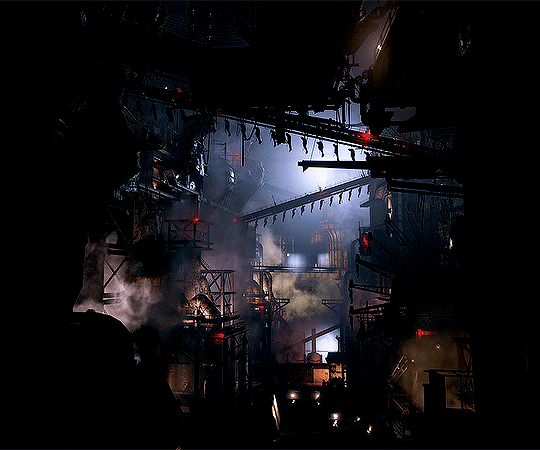
● HAULER

Mutant corpses revived by the Cadou parasite, the Haulers were modified by the vengeful engineer Karl Heisenberg, using electrodes from attached headgear of his own creation to stabilize their neural activity. Despite the 1.01s having combat capabilities that's virtually non-existent, the Haulers were repurposed as slaves that serve as workers and low-level guards under Heisenberg's control.
Humanoid appearance
Surgically mounted headgear
Capable of wielding handheld weapons with accuracy
Ashen complexion
Limited mobility, slow moving
Moderate intelligence
Heightened aggression
Moderate physical strength, durability and endurance
Crystallization of cellular structure after death
● SOLDAT EINS

Empowered by the mutagenic Cadou and industrial technology, the Soldat Eins were the basic grade of soldier from Lord Heisenberg's army of mechanized corpses. A more proficient machine of murder thanks to its Cadou Control Reactor and weaponized prosthetic, the Eins series would be the first of many variants to utilize the dead for the Village Lord's vendetta.
Humanoid appearance
Surgically mounted headgear
Exposed reactor replacing heart
Singular arm replaced with mechanized industrial drill implant
Ashen complexion
Limited mobility, slow moving
Moderate intelligence
Heightened aggression
Heightened physical strength, durability and endurance
Crystallization of cellular structure after death
Detonation of reactor core after sustaining significant damage
● SOLDAT ZWEI
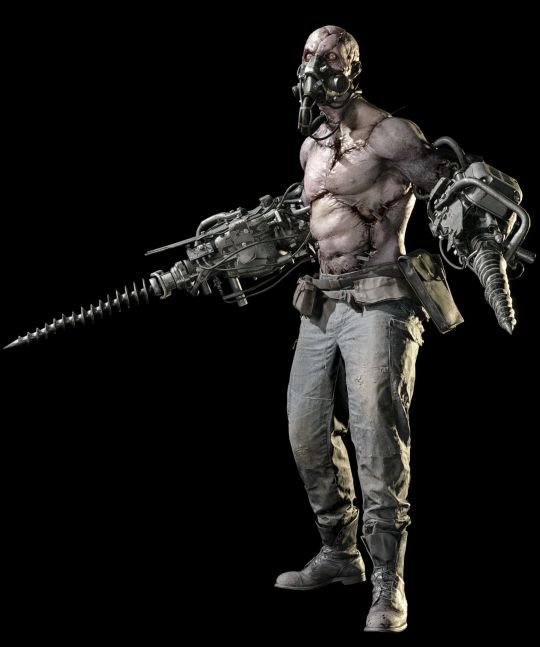
An upgrade to the Soldat Eins bioweapon, the Zwei series were augmented with dual industrial-grade drills to remove the weakness of their necrotic flesh. With their Cadou Control Reactor relocated to a less conspicuous spot on their patchwork body, a single Soldat Zwei is capable of annihilating multiple targets endowed with the mutant parasite in a singular minute.
Humanoid appearance
Surgically mounted breathing apparatus
Exposed reactor replacing heart relocated to upper back
Both arms replaced with mechanized industrial drill implants
Ashen complexion
Limited mobility, slow moving
Moderate intelligence
Heightened aggression
Heightened physical strength, durability and endurance
Crystallization of cellular structure after death
Detonation of reactor core after sustaining significant damage
● SOLDAT JET

A flight-based variant of the Soldat Enhancement Development Project, the Jet series were developed for more mobile soldier amongst Lord Heisenberg's mechanized army of the undead. Equipped with rocket engines and head stabilizing wings, the Soldat Jet's three-dimensional maneuverability can get across even the most rugged terrain in combat deployment.
Humanoid appearance
Equipped with crude armor-like scrap metal encasing upper body
Equipped with rocket engines and head stabilizing wings for flight
Exposed reactor replacing heart
Both arms replaced with mechanized industrial drill implants
Capable of short distanced aerial attacks
Moderate intelligence
Heightened aggression
Heightened physical strength, durability and endurance
Crystallization of cellular structure after death
Detonation of reactor core after sustaining significant damage
● SOLDAT PANZER
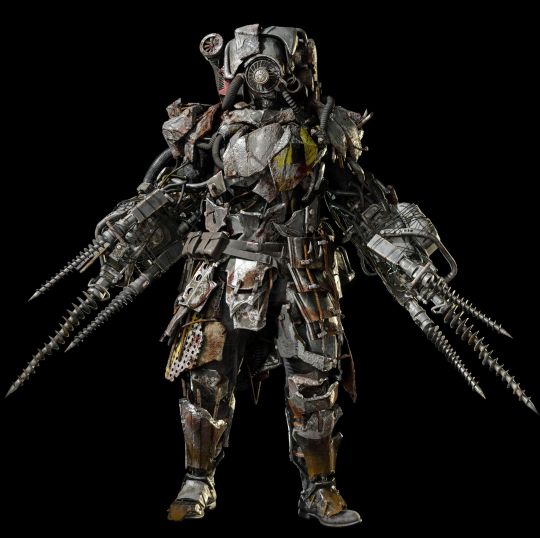
An armored mutant from Lord Heisenberg's Soldat Enhancement Development Project, the Panzer series were engineered as soldiers with absolute protection against conventional firearms. Encased in full-body aluminum alloy armor, the Soldat Panzer are formidable bioweapons amongst Heisenberg's arsenal with their unyielding defense and overwhelming destructive power.
Humanoid appearance
Exposed reactor replacing heart
Overall body encased in crude armor-like aluminum alloy
Both arms replaced with mechanized industrial drill(s) implants
Ashen complexion
Limited mobility, slow moving
Moderate intelligence
Heightened aggression
Heightened physical strength, durability and endurance
Crystallization of cellular structure after death
Detonation of reactor core after sustaining significant damage
● STURM

A prototype Soldat-based bioweapon developed by Lord Heisenberg, the Sturm's turbo-prop aircraft engine in place of its torso makes it an unbeatable force through head-on confrontations. Deemed a failure due to its uncontrollable nature and self-destructive capabilities, the Sturm was instead utilized as a subterranean executioner for Heisenberg's factory.
Humanoid appearance
Surgically mounted turbo-prop engine to upper body
Exposed reactor replacing heart
Loss of hands and forearms due to oversized propeller
Low intelligence
Heightened aggression
Superhuman physical strength, durability and endurance
Crystallization of cellular structure after death
Detonation of reactor core after sustaining significant damage
#resident evil 8#resident evil 8 village#resident evil village#re8#re8 village#re village#Lord Heisenberg#Karl Heisenberg#Heisenberg
113 notes
·
View notes
Text
Shui Long Yin VR Metaverse: Technologies and Digital Assets, and the melon about it being released in Summer 2025
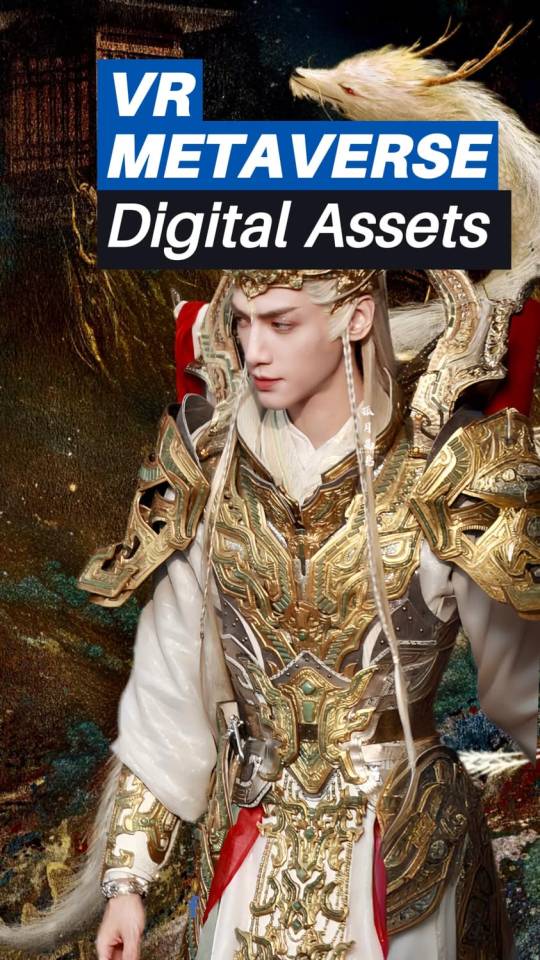
What is the metaverse?
The Shui Long Yin metaverse is a parallel world closely resembling the real world, built through the use of digital modelling and technologies such as VR and AR, and designed to exist permanently.
This virtual realm integrates cutting-edge advancements, including blockchain, augmented reality, 5G, big data, artificial intelligence, and 3D engines.
When you acquire a ticket to this world, you gain a digital asset, allowing you to become an immersive citizen within the Shui Long Yin Metaverse.
Every item within Shui Long Yin can be experienced through Augmented Reality using VR devices, providing a seamless blend of the physical and digital realms. These digital assets are permanent, and in some cases, overseas users may trade or transfer their tickets to enter the Shui Long Yin world.
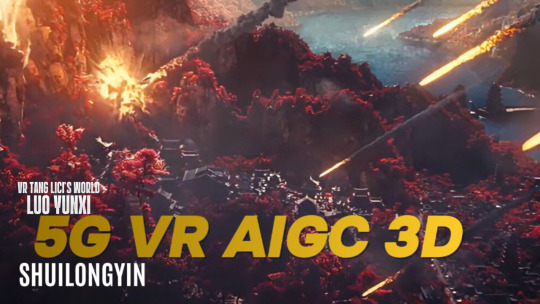
What is VR and AR?
Virtual Reality (VR) is a technology that enables users to interact within a computer-simulated environment.
Augmented Reality (AR), on the other hand, combines elements of VR by merging the real world with computer-generated simulations. A well-known example of AR is the popular game Pokémon Go, where virtual objects are integrated into real-world surroundings.
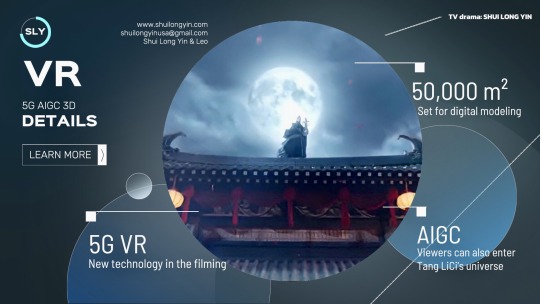
Tang LiCi's universe
The Shui Long Yin film crew has digitally modeled the core art assets, 50 000 square meters.
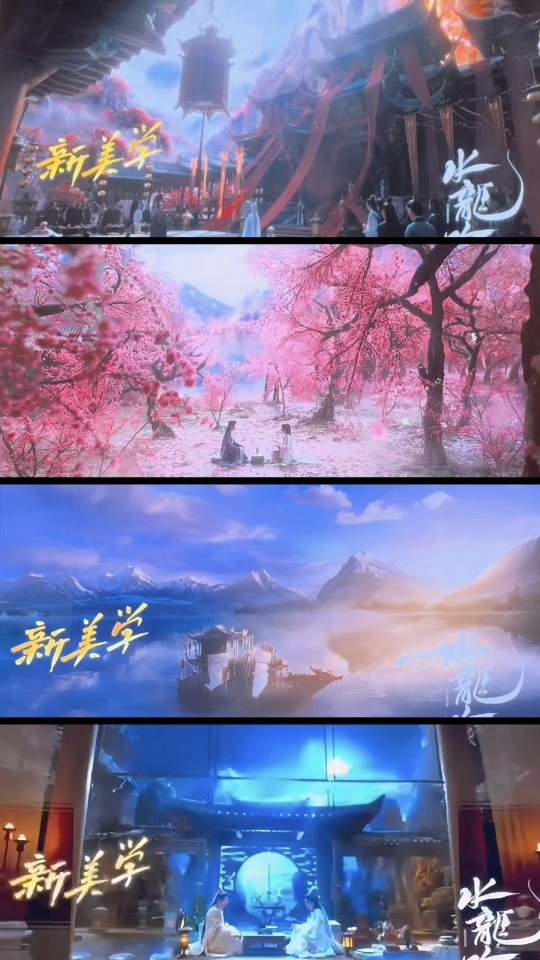
What technologies does China Mobile & Migu bring to the table?
China Mobile served as the lead organizer for the 2023 World VR Industry Conference. Its subsidiary, Migu, has also been dedicated to advancing projects in this area.
Shui Long Yin is their first priority this summer 2025.
5G+AI: VR world in Metaverse
AIGC AR 3D: Using AI technology in graphics computer, with the best trained AI system in China.
Video ringtones as a globally pioneering service introduced by China Mobile.
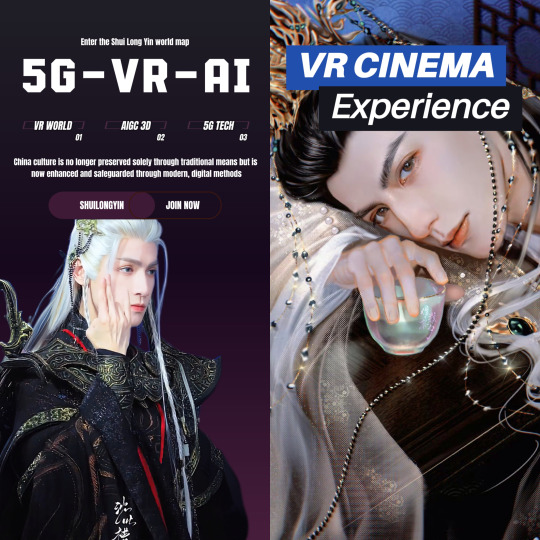
Shui Long Yin from Screen to Metaverse to Real Life: Epic Battles and Intricate Plotlines
The United States and China are world pioneers in the development of TV drama integration VR Metaverse. Notably, Shui Long Yin is the sixth TV drama map worldwide to be merged into the Metaverse.
How can we enjoy these technologies?
-- First we need 5G -- According to a report by the Global Mobile Suppliers Association (GSA), by June 2022:
》There are 70 countries around the world had active 5G networks, you can fully experience all the technology featured in Shui Long Yin.
Example: South Korea, China, and the United States have been at the forefront. Follow after are Japan, United Kingdom, Switzerland, Australia, Taiwan, United Arab Emirates, Saudi Arabia, Viet Nam...
》No worries—even in countries without 5G, you can still watch the drama and enjoy AIGC and 3D technology through the streaming platforms Migu Video and Mango.
•Mango available on IOS and Android, Harmony OS
•Migu (Mobile HD) soon availabe on IOS and Android, Harmony OS
-- Second, we need VR devices --
In country where VR is already commonplace, such as the United States, owning a VR device is considered entirely normal. Users can select devices that best suit their preferred forms of home entertainment.
European countries have also become fairly familiar with VR technology.
However, it is still relatively new to many parts of Asia. When choosing a VR device, it’s important to select one that is most compatible with your intended activities, whether that’s gaming, watching movies, or working.

It's no surprise to us that the drama Shui Long Yin will be released in the summer 2025, but it will also be coinciding with offline tourism to Long Yin Town in Chengdu, online VR Metaverse travel, and 3D experiences on the new streaming platforms Migu and Mango. Stay tuned!
Tv drama: SHUI LONG YIN Shui Long Yin & Leo All music and image are copyrighted and belong to the respective owners, included the official film crew SHUILONGYIN.
#shui long yin#tang lici#水龙吟#唐俪辞#luo yunxi#luo yun xi#leo luo#罗云熙#cdrama#chinese drama#long yin town#long yin town vr
5 notes
·
View notes
Note
Hello! I’ve enjoyed reading your rwby analysis posts, especially the things you’ve had to say about Penny. The amount of care you put into thinking and writing about her is great. I’m curious what you thought about Penny getting turned into a human, because… I personally really didn’t like it. It just really hurt me that after she was attacked repeatedly because she was built differently, that the solution to that was to remove everything which was different/unique about her and make her “normal.” And then have the actual physical representation of her differences violently die and then be obliterated like they were some horrible, hideous thing.
A good chunk of her story seemed to revolve around being just as much a person as anyone else even though she had a body that worked differently. And I sure did relate to that irl! But then turning Penny human seemed to send the message that Penny could only actually be a full and happy person (such as immediately discovering how wonderful hugs feel) if she was normal. I want to believe I’m taking that scene the wrong way, but… I’m not sure how else I can interpret what happened. So yeah, I’m curious what you think! I’ll be interested to read your thoughts, whatever they may be.
ooh, well, i’m not keen on the way the fandom writ large interprets the scene (as ‘penny became human’/‘penny became real’) and i like how it was done because imo it is really NOT framed as a positive transformation?
there’s an element of relief and joy to it of course—because everyone’s glad that penny survived this ordeal with the virus—but, as you say, the self-destruction of her robotic body is a big focal point of the scene and it is done in a very horrifying way, with the camera moving between penny’s POV as she watches it happen and her robotic body’s POV as it desperately tries to reach her before succumbing to the virus. and penny herself is profoundly disturbed by the experience—she’s not happy to be ‘free’ of that body at all, and ruby hesitantly asks if she’s alright because penny clearly isn’t.
so while penny does then find a small thing to appreciate about her new flesh body and that momentarily alleviates the horror… the tone is very much set by the amount of focus given to penny watching a part of herself die and, after that small burst of joyous relief, watching her old body crumble into ash and flinching away with horror again.
to me, this reads as a rebuke of how flippant yang was about the loss—“the mechanical parts are just extra,” except penny’s body isn’t truly equivalent to a prosthetic, right? that’s just her body.
it’s not all she is, but it’s also a lot more like the arm yang lost than it is like the prosthetic yang got afterwards. penny loses a core part of her identity…
…which is reinforced later, inside the portal, when penny is taken off guard by the abrupt realization that she no longer has floating array. weapons are a fundamental part of huntsmen identity, seen and understood as “extensions of our selves,” and penny’s is literally destroyed by her involuntary transformation—involuntary in the sense that it’s a choice she was forced to make under extreme duress thanks to watts—and she has to recreate that piece of herself with magic.
and there’s smaller, subtler things wrong, too. i think the amount of focus put on her bare feet is meant to highlight that she does not have thrusters any more—an essential aspect of her natural mobility is just gone, again leaving her dependent on the maiden powers to do something she used to be able to just DO.
or consider how disoriented she seems right before cinder gets her. in her original body, penny had sophisticated tactical software built into her sensory array which among other things made her virtually immune to emerald’s semblance. she could see infrared light and aura and the tactical analysis program worked much, much faster than any human could keep up with—because her physical brain was a computer! and then she loses that and spends the entire fight mainly getting clobbered and then struggles to keep track of what’s even happening when cinder gates her off from her allies!
her new body is healthy and whole by human standards, but measured against what penny had before… the narrative gives, like, a LOT of attention to signaling that penny has been measurably disabled in a multitude of ways. if she wasn’t also the winter maiden—& bear in mind that penny only became the winter maiden BECAUSE of what her original robotic body could do!—penny would have been rendered utterly helpless by this transformation. no weapon, no flying, in a much more fragile and vulnerable body that could feel pain. (think about how much screaming she does during that final fight, compared to the time she gets flung several blocks by a grimm so hard there’s an impact crater and she’s like “ouch! :)” about it)
and obv, that fragile new body is the only reason cinder was able to kill her at all. i think that’s sort of the point: penny did the equivalent of *barely* surviving a debilitating illness, went from her sickbed to a battlefield, tried to fight like that, and died because she in a state of extreme physical vulnerability due to recent illness. that’s why all of her friends were so insistent that she not participate in the fight—she wasn’t ready to be fighting! if she’d lived, she would have needed to spend quite a long time recovering, learning and accepting her new limitations, and training within those new limits.
so, to me? the narrative framing of the transformation feels somber, with “she lived! it worked!” being the silver lining on what is otherwise a tragic outcome. watts infected her with this brutal, horrific virus and the only way to save her life was to sacrifice a fundamental part of her self, in this acutely traumatizing way. i think the fandom collectively sort of tunnel visioned on the pinocchio narrative of ‘becoming a real girl’* to such a degree that the bittersweet framing and the underlying horror of what happened to her gets widely overlooked. and i don’t think those tragic/horrific notes are there by accident—the narrative puts quite a lot of emphasis on them, and deliberately bookends the joy of “do hugs always make you feel this warm?” with those moments of intense horror with the violent death and then destruction of her robotic body.
(*something that… really isn’t a prominent theme with penny?, because her struggle with personhood is centered on how *other people* treat her like an object and i would argue her pinocchio ‘becoming a real boy’ moment is actually her acceptance of the maiden power—not because that ‘proves’ she’s a person or whatever, but because it’s a moment of emotional self-actualization where she chooses to do the right thing according to her own judgment instead of mindlessly following orders like the puppet ironwood expects her to be. it’s symbolic! & that gets called back to explicitly by winter, later, with “you were *always* the real maiden, i was the machine,” the ‘realness’ in the pinocchio narrative here is about emotional authenticity and refusal to sacrifice conscience or heart in the name of following orders.
rwby is… pretty profoundly uninterested in the question of ‘does the robot girl count as a person?’ because it answers that within literal seconds after revealing that she is a robot with an emphatic ‘yes, obviously, she has a soul, zero ambiguity here’ lmao. what it does do is leverage pinocchio to explore themes of dehumanization and personhood within an authoritarian military regime.)
so yeah, that’s how i read that. it’s joyous because she lives but it’s also not a victory earned without grievous loss, and the tragedy is exacerbated because she *does not have time* to catch her breath / process / learn how to live in her new, disabled body before cinder… cinders.
136 notes
·
View notes
Text
Robotics Division of the Rebel Army
The Robotics Division of the Rebel Army is a division serving under Annika Sörenstam's command. They consist of the best engineers and roboticists whom develops the most powerful war machines in the world.
Summary
After being recruited by the Rebel Army, Annika showed immense skill in robotics and engineering. Inspired by a fictional character, Doctor Ivo Robotnik (or Eggman), Annika built multiple machines to assist the Rebel Army in their goal for world domination. Unlike the bumbling Eggman, Annika's machines are devastatingly effective against the Regular Army. The reason for this effectiveneas is thanks to higher quality materials such as renforced hyper-titanium, arc reactive cores, and plasma enhanced weapondary and for her robots.
Under Annika's leadership, the division has attracted top-tier engineers, rouge scientists, disgraced university professors, black-market tech smugglers, and even former Regular Army personnel turned traitor. With virtually unlimited resources and support from global allies like the Amadeus Syndicate, the Robotics Division is a true force of the Rebel Army's might.
Leader
Annika Sörenstam
Members
Pravi (Second In Command)
Chrome (Rebel Army A.I.)
Indium (Cyborg)
Luna Washington (Builder)
Unnamed Reserchers
Affiliated With
Rebel Army
Arabian Infantry
Japonese Army
Amadeus Syndicate
Enemies With
Regular Army
Android Unit
PF Squad
S.P.A.R.R.O.W.S
Ikari Warriors
Equipment
Sören Walker
Sören Mobile
U-400 King
U-401 Queen
.Odin
.Njord
.Thor
.Loki
The Juggernaut Series (UENJ-Ultimate Enforcer Juggernaut, UEXJ-Ultimate Explosion Juggernaut, USCJ-Ultimate Scout Juggernaut, UWAJ-Ultimate War Juggernaut, and UTEJ-Ultimate Terminator Juggernaut)
Brainstorm
Brainstorm Mk II
Eftron
Project: Freya
3 notes
·
View notes
Text
The Future of Digital Marketing: Trends You Can’t Ignore in 2025 Digital marketing is transforming rapidly. In 2025, staying ahead means embracing tech, personalization, and trust. Here are the top trends to watch:
AI-Powered Everything From automating ads to creating personalized content and customer journeys in real time. In 2025, it's the core of smarter, faster campaigns.
Hyper-Personalization at Scale With data from multiple touchpoints, brands now deliver ultra-targeted campaigns using AI, smart segmentation, and dynamic content— creating experiences that truly connect.
Voice and Visual Search Optimization By 2025, more consumers will use voice assistants like Alexa or Google Assistant and visual search tools like Google Lens to discover products and services. That means your SEO strategy must include conversational keywords, structured data, and optimized images to stay searchable across new platforms. Conversational Keywords: People talk differently than they type. Voice searches are often longer and more natural-sounding. Incorporate question phrases and natural language that matches how users speak (e.g., “best eco-friendly running shoes near me”). Structured Data: Adding schema markup helps search engines understand your content better. It boosts your chances of appearing in rich results, voice answers, and visual search contexts. Optimized Images: Visual search tools rely on clear, well-tagged images. Use descriptive file names, alt text, and ensure images load fast and are high quality to increase your visibility.
Influencer Marketing 2.0 Micro and nano influencers will dominate the space with authentic, niche content that drives trust and engagement. Brands in 2025 will focus less on follower count and more on genuine influence and community connection. Expect long-term brand-influencer partnerships, AI-generated influencers, and performance-based influencer campaigns to become standard.
Short-Form Video Still Reigns Thanks to platforms like TikTok, Instagram Reels, and YouTube Shorts, short-form video is king. In 2025, brands will invest more in snackable, mobile-first video content that educates, entertains, and converts. The key: authentic storytelling, user-generated content, and interactive formats like polls and challenges.
Cookieless Future & First-Party Data With third-party cookies on the way out, 2025 will see a shift toward privacy-first marketing. Brands will need to invest in first-party data collection via email signups, loyalty programs, surveys, and gated content. Transparency, consent, and data protection will be non-negotiable for customer trust.
Immersive Experiences (AR/VR) Augmented Reality (AR) and Virtual Reality (VR) are transforming how customers explore products. From virtual try-ons to immersive 3D shopping, these technologies will redefine the e-commerce and retail experience. Brands embracing AR/VR will stand out by offering interactive, memorable user experiences.
Sustainable and Ethical Marketing Consumers in 2025 expect brands to stand for something. Sustainability, inclusivity, and social responsibility are no longer optional they’re expected. Marketing strategies will focus on authentic brand values, eco-conscious practices, and purpose-driven messaging. Final Thoughts The digital marketing landscape in 2025 will be faster, smarter, and more human than ever. To succeed, brands must combine cutting-edge technology with authenticity, empathy, and ethical practice. KEYWORDS The future of digital marketing. Top trends. Campaigns. 2025. Digital Marketing.
2 notes
·
View notes
Text

#Virtualized Evolved Packet Core Market#VEPC Market#Mobility Management Entity#Home Subscriber Server#Packet Data Network Gateway#Policy and Charging Rules Function#Mobile Private Network & Mobile Virtual Network Operator (MPN & MVNO)#Long-term Evolution & Voice over Long-term Evolution (LTE & VoLTE)#Telecom Operators#Internet of Things & Machine to Machine
0 notes
Text
Embracing Digital Transformation in 2025: How IT Fruits Technologies Helps Your Business Stay Ahead
Introduction In today’s rapidly evolving digital landscape, staying ahead means embracing the latest technologies and adapting to new trends. At IT Fruits Technologies, we believe digital transformation is not just a buzzword — it’s the key to unlocking growth, efficiency, and innovation for businesses of all sizes.
Why Digital Transformation Matters in 2025
The year 2025 has brought unprecedented advancements in technology. From smarter mobile applications to immersive AR/VR experiences and interconnected IoT systems, businesses now have more tools than ever to streamline operations and enhance customer engagement. Companies that invest in digital transformation are seeing increased productivity, improved customer satisfaction, and a stronger competitive edge.
Our Core Services: Empowering Your Business
1. Mobile App Development We build custom iOS, Android, and cross-platform apps that deliver seamless user experiences and drive business results.
2. Web Development Our team creates responsive, secure, and scalable websites and web applications tailored to your unique needs.
3. E-commerce Solutions We design robust online stores with smooth checkout experiences, helping you expand your reach and boost sales.
4. IoT (Internet of Things) Development Connect your devices and automate processes with our smart IoT solutions, enabling real-time data and smarter decisions.
5. AR/VR Development Engage your customers and train your teams with cutting-edge augmented and virtual reality applications.
6. Unity Game Development From casual games to complex simulations, our Unity experts bring your gaming ideas to life.
7. Startup & MVP Development Have a new idea? We help startups validate, build, and launch minimum viable products quickly and cost-effectively.
Why Choose IT Fruits Technologies?
Expert Team: Experienced professionals passionate about technology and innovation.
Client-Centric Approach: We listen, understand, and deliver solutions that fit your business goals.
End-to-End Support: From ideation to launch and beyond, we’re with you at every step.
Proven Results: Our clients see measurable improvements in efficiency, engagement, and ROI.
Ready to Transform Your Business?
Digital transformation is a journey, and IT Fruits Technologies is your trusted partner. Whether you’re a startup or an established enterprise, we have the expertise to help you thrive in 2025 and beyond.
Contact us today to discuss your project or schedule a free consultation!
**#DigitalTransformation #ITFruits #AppDevelopment #WebDevelopment #IoT #ARVR #GameDevelopmentStartupSuccess
2 notes
·
View notes
Text
Trusted outsource software development teams - SSTech System

Outsource software development is the practice of relinquishing software-related duties to outside singularities or organizations. Outsourcing is used by firms to acquire software services and products from outside firms that do not have direct employees or employees under contract to the business entity that is outsourcing.
Infect, the outsourcing market worldwide is projected to grow by 8.28% (2025-2029) resulting in a market volume of US$812.70bn in 2029. This model is highly versatile and suits businesses of all sizes.
Start-ups often use outsourcing to develop MVPs quickly, while established companies might seek custom software development services or AI outsourcing services to address complex challenges. Outsourcing can include working with offshore development teams, global software development partners, or local experts like Australian software development experts for specific projects.
The benefits of outsourcing software development
Outsourcing has become a cornerstone for modern businesses due to its numerous advantages. Here’s a closer look at the key benefits:
1. Cost efficiency
Perhaps the biggest incentive for sourcing solutions from outsourcing service providers is the cost cutting factor. For instance, offshore software development in India provides expertise services at comparatively lower cost than that of in-house developed services in Western countries. This efficiency enable the enactments of cost savings in some other strategic sectors of the organization.
2. Access to global talent
Outsourcing can help to discover the wealth of new talents as well as the skills of professionals from other countries. No matter Whether it’s AI and machine learning integration, web application development in Australia, or outsourced healthcare software development, businesses can find experts in virtually any domain.
3. Scalability and flexibility
Outsourcing offers flexibility that is unparalleled in many organizations today. This is because; firms are able to expand and contract particular teams depending on the specific demand in projects. For example, outsourced IT solutions help business organizations prepare for different conditions while not having to employ permanent workers.
4. Faster time-to-market
With reliable software development teams in Australia or offshore development teams in India, businesses can speed up their project timelines. This helps innovations to make it through to the market early enough, which is useful for companies.
5. Focus on core activities
By delegating tasks like software maintenance and support or cloud software development in Australia to outsourcing partners, businesses can focus on their core competencies and strategic goals.
6. Reduced risk
In-house staff and trained outsourcing partners come with best practices, methods and procedures which when implemented reduce the chances of project hitch. Working with the top-rated IT outsourcing companies in Australia gives you confidence that your project is in safe hands.
Choosing the right outsourced software development partner

In the period from 2023 to 2027, the revenue of software outsourcing is forecasted to thrive at a CAGR of 7.54%. So, outsourcing partner selection is one of the most vital components since it determines the success of a given venture. Here are essential factors to consider:
1. Technical expertise
Check the partner’s competency and his knowledge of the field. For instance, SSTech System Outsourcing offers comprehensive solutions, from AI development services in India to mobile app development outsourcing in Australia.
2. Proven track record
Look for partners with a strong portfolio and positive client testimonials. A proven track record in delivering custom software development services or managing outsourcing software development contracts is a good indicator of reliability.
3. Effective communication
Effective and open communication is extremely important if the project is to be successful. Work with people who give frequent reports and employ efficient media to overcome the differences in time areas.
4. Cultural compatibility
There has to be a cultural match or at least appreciation for each other’s customs for there to be harmony in the working relationship. As such, staffed with proficient Australia software development experts or offshore development teams, whose experience is to work on global markets can coordinate and blend well with your work culture.
5. Security and compliance
You have to make sure that your partner complies with the standards and the policies that are in the industry. This is especially substantial for all information-sensitive projects such as outsourced healthcare software development or cloud software development in Australia.
6. Scalable infrastructure
Choose a partner capable of scaling their resources and infrastructure to meet your project’s evolving needs. This is crucial for long-term collaborations, especially with global software development partners.
AI-powered tools for outsourced development teams
According to a report from the US Bureau of Labor Statistics, software development ranks among the most sought-after professions. Hence, AI is at the forefront of reshaping the outsourcing industry. Therefore, the implementation of artificial intelligence will add value to business processes, make workflow easier, and boost the results of projects. Here are some examples:
1. Automated code reviews
Tools like DeepCode and SonarQube assist outsourced teams in detecting whether errors reside in the code line or not, and whether code needs to be enriched or not. This is particularly accurate concerning AI outsourcing and in-house development industries.
2. Predictive analytics
Automated analytics tools can predict such things as the time it will take to complete the project, how much money it will cost, and what risks are possible in a software development outsourcing scenario.
3. Smart project management
Tools and platforms such as Jira and Monday.com, when empowered with AI, allow the coordination of tasks and the tracking of progress and resource allocation.
4. AI collaboration tools
Communication and collaboration with internal members and offshore software development Australia partners get facilitated through applications that include, Slack, Microsoft Teams, and zoom with integrated AI functions.
5. Natural Language Processing (NLP)
AI-powered chatbots and virtual assistants simplify communication and issue resolution, making them valuable for managing outsourced IT solutions.
Best practices for managing outsourced development teams
Outsourced teams should be mandated and coordinated following a number of recommendations to ensure the efficiency of the entirety of the outsourcing process.
Here are the best practices to ensure your project’s success:
1. Set clear objectives
Make it clear to your project team, stakeholders, and other relevant parties what the parameters of the project are, what it is that you expect out of it, and what you expect to get from it in return. This fostaines consistency between your team and the outsourcing partner to increase efficiency in service delivery.
2. Choose the right tools
Use project tracking and collaboration software approaches to track and evaluate progress and meet regular informality and collaboration targets.
3. Foster a collaborative environment
It is worthy of note that constant communication is key to ensuring that your outsourcing team is on the same page with you. Fresh produce and feedback mechanisms need to be provided in order for there to be trust as is needed in project management.
4. Draft comprehensive contracts
There should be a comprehensive outsourcing software development contract. It should address issues to do with confidentiality, ownership of ideas and concepts, plea structure and mode of handling disputes.
5. Focus on long-term relationships
Building a long-term partnership with trusted providers like SSTech System Solutions can lead to consistent quality and better project outcomes.
Conclusion
To keep up with technology, outsourcing software development offers businesses solutions and support that can enable the creation of complex solutions out of mere ideas. Outsourcing has the benefits of minute overhead cost and is also a rich source of globally talented employees, and it offers the advantage of early time to market. Whether you’re looking for mobile app development outsourcing in Australia or seeking offshore software development in India or opting for AI outsourcing services, the potential is huge.
Such companies can only benefit from opting for reliable outsourcing companies such as SSTech System Outsourcing and embracing industry best practices to promote the success of business project implementations while enhancing market relevance. As technologies like AI and cloud computing are still changing the face of the outsourcing market, software development outsourcing will still be important for any company that wants to survive in a digital world.
Take the first step today—partner with global software development partners and unlock the full potential of your ideas with the power of outsourcing.
#SSTech System Outsourcing#SSTech System Solutions#AI outsourcing services#cloud computing#offshore software development#Outsource software development#AI outsourcing#web application development in Australia#custom software development services#mobile app development#outsourced IT solutions#cloud software development#IT Support & Maintenance Services
4 notes
·
View notes
Note
Hi! I have to admit that I know nothing about Fallout but would like to understand your AU so idk could you explain Fallout for beginners please? (and maybe how the AU works specifically) 🧡
I’m going to try and put this in the most straightforward terms I can and maybe steal a few things from Wikipedia if I can’t.
And I hope you don't mind, I'll publish this as well so others can learn.
There are currently 7 Fallout games: Fallout, Fallout 2, Fallout Tactics: Brotherhood of Steel, Fallout 3, Fallout: New Vegas, Fallout 4, and Fallout 76. (This is not counting the small things like mobile games or the table top games, or even the freaking pinball game either) PLUS there is also the “Fallout” TV show on Amazon (It's good, My dad who knows NOTHING of Fallout loved it) ▬ The Show on Amazon is based in Los Angeles.
▬ The setting, back story, lore, just a little history:
The series is set in a fictionalized USA in an “alternate history scenario” that diverges from reality after 1945, following World War II. In this alternative "golden age", where atomic physics serves as the foundation of scientific progress, which leads to a bizarre socio-technological status quo. This means things like advanced robots, nuclear-powered cars, directed-energy weapons, and other futuristic technologies are seen alongside 1950s-era computers and televisions.

▬ Nuka Cola ad featuring Nuka Girl leaning heavily into the atomic/nuclear aspect
The United States divides itself into 13 commonwealths, and the aesthetics and Cold War paranoia of the 1950s dominated the American lifestyle well into the 21st century.

▬ Map of all of the Fallout Commonwealths
The a whole bunch of history happens, it’s honestly wordy and gives the lead-up to how the bombs dropped on the morning of October 23, 2077, a “global nuclear exchange”, which subsequently created the post-apocalyptic United States, the setting of the Fallout world.
▬ Now, in my AU, I say that Buck is from a Vault.
The U.S. government, having foreseen this outcome just a few decades earlier, began a nationwide project to build fallout shelters known as "Vaults". The Vault-Tec Corporation designed the Vaults as public shelters, each able to support up to a thousand people. Something round 400K Vaults would have been needed if they actually wanted to help the American people, but only 122 were commissioned and constructed.

Vault Boy; He is the corporate mascot of the Vault-Tec, His female counterpart is Vault Girl. They appear in virtually every released game and evolved over the years into a symbol of the Fallout franchise in general.
However, the Vault project was not intended as a viable method of repopulating the United States; instead, most Vaults were secret social experiments and were designed to determine the effects of different environmental and psychological conditions on their inhabitants.

▬Lemme just use Norm Maclean (Fallout Series) here to showcase the sort of view in the vault and the lovely blue and gold jumpsuits ALL vault dwellers basically wear.
Now, only Seventeen control Vaults were made to function as advertised, in contrast with the other Vault experiments. However, they were usually shoddy and unreliable due to most of the funding going towards the experimental ones. Many Vaults remained sealed as part of their respective experiments even after the radiation had reached safe levels.
EDIT: I forgot to actually talk about the Brotherhood of Steel.
▬ Eddie is a former Brotherhood of Steel Knight.
The Brotherhood of Steel, commonly abbreviated to BoS, is a quasi-religious technocratic military order founded in the immediate aftermath of the Great War The BOS' core purpose is to preserve advanced technology and regulate its use. They believe humanity cannot be trusted with the means to destroy itself, and they think that acquiring technology would prevent another apocalypse. The Basics of BOS came from the fall of the western Roman Empire when the knights and scribes kept the fire of civilization going after the empire imploded. The BOS is a military order with a strictly enforced hierarchy and chain of command. At the foundation, that mandates obedience to one's superiors and forbids circumventing ranks when giving orders. When it comes to the individual members of the BOS, loyalty to and defense of the organization are the top priorities, - 1st: Loyalty to and defense of the organization - 2nd: Dedication and loyalty to the mission. - 3rd: Dedication and loyalty to one's superior officer. Brotherhood members are expected to follow each of these rules in that order. If one's superior should act against the interests of the organization or mission, the third rule is superseded by the second or first rule.

▬ Brotherhood of Steel Ranking Structure
The Brotherhood has been featured in every game and other entry in the Fallout series in one form or another.
▬ My manip of Eddie in a Brotherhood jumpsuit
Eddie's History with the BOS without spoilers

▬ My manip of Eddie in a Brotherhood jumpsuit
While homosexual relationships are generally tolerated, they are pressured to instead seek relationships that will result in 'repopulation.' This leads Eddie to be arranged with Shannon, which then leads to Chris's birth, though Eddie and Shannon are able to keep Chris' Cerebal Palsy (though in the FO Universe, it would be considered his 'disorder or ailment) secret from the BOS for the first few years. BOS finds out about Chris, and would never tolerate someone like Chris within their ranks. Eddie ultimately decides he can no longer remain a part of them, and following his own moral compass, he chooses to desert the BOS. The Diazs, on their own, now in this new reality, Eddie is constantly on the lookout, aware that his status as AWOL from the BOS makes him a target.
▬ I have planned in the future that Karen is a former Enclave Scientist.
The Enclave is another military organization dedicated to the execution of an all-inclusive holocaust of non-members, who they dehumanize as "genetic non-compliance offenders." While being the continuation of a pre-war American deep state consisting of high-ranking political, military and corporate figures, its members publicly claim to be the direct continuation of the United States of America and its government after the destruction of the world during the Great War.

▬ Enclave power armor, X-01 power armor
Without going too in-depth with them, it's obvious I hate them, they're the worst, they Suck, and I'm glad Karen left them (In my AU).
here are things I may mention in my AU (when it comes to finally posting my fic)
Pip Boy: The Pip-Boy (Personal Information Processor-Boy) is a wrist computer given to the player (Vault-Dweller) early in the games and series, which serves various roles in quest, inventory, and battle management, as well as presenting player statistics.

▬ This version of the Pip-Boy is not stated in-series, though the official replica sold by The Wand Company is called the Pip-Boy 3000 Mark V
Power Armor: Power Armor, is a type of powered exoskeleton featured in every game in the Fallout series. It allows for protection from enemy fire and enables the wearer to carry cumbersome weapons and other objects with ease. There are so many types, levels and styles of Power Armor. It is considered an iconic part of the Fallout universe, an effective marketing tool for a faceless protagonist, and a prominent symbol within the game's lore. ▬ “Post-war” the Power Armor is most widely used by the Brotherhood of Steel, a cult-like organization that collects and preserves technology (My husband said the BOS is like Mormons and their obsession with Geneology)
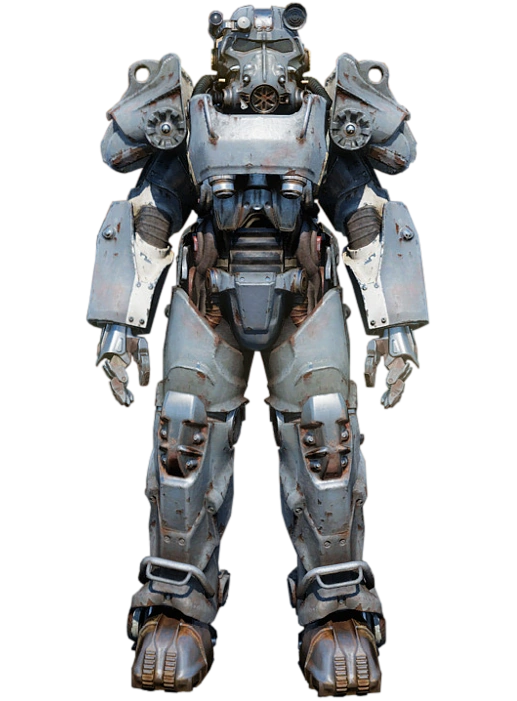
▬T-60 Power Armor
There are INSANE Animals that roam the ‘wasteland’. Some were modified by the Government (ie. Death Claws), but some were also just changed by radiation.
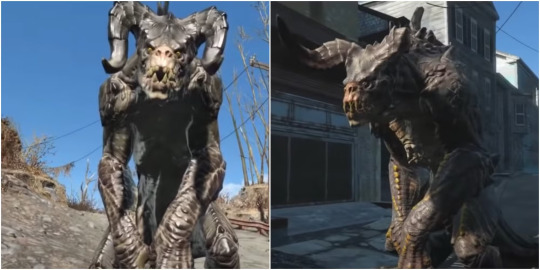
▬ BAD: genetically engineered creatures developed by the United States military to replace humans during missions, but they escaped into the wild in the aftermath of the Great War

▬ GOOD: Brahmin are mutated two-headed cattle; they still provide meat, milk, hide, and manual labor.
Ghouls... Ghouls are humans mutated by radiation, rather than killed by it. The mutation process, referred to as "ghoulification", this typically results in an extended lifespan, if not functional immortality, real-time regeneration of wounds allowing for reattaching limbs, and immunity to direct damage resulting from irradiation. However, it changes their appearance, resembling rotting corpses, burn victims, or walking corpses

▬ Cooper Howard - The Ghoul From the Fallout Amazon series

▬ Feral Ghouls in Fallout 4
Now, with my AU, I’m doing a small mix of The TV show, but throwing in elements of Fallout 4 and New Vegas (Kinda) While I won't delve into the details of every single game and its historical context, I hope this overview will provide you with enough information on the basics of Fallout? If you have any questions, please do not hesitate to ask!
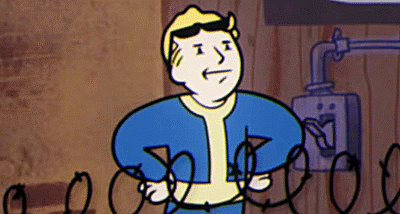
Much Love, ▬ Kenna
#answered#travellingdragon#asks#Fallout Fundamentals#fallout/911#fallout 911 mashup#911 Fallout AU#911 AU#In this essay...
5 notes
·
View notes
Text
Top Features of Uber suggest That Every Digital Marketer Should Know
In the sector of virtual advertising and marketing, in which visibility and engagement are key, having the proper tools at your disposal could make a widespread difference. Among the plethora of search engine marketing tools available, Uber suggest has emerged as a powerful and flexible answer that caters to companies, marketers, and individuals aiming to decorate their on-line presence. Created through fam end marketer Neil Patel, Uber suggest offers a variety of capabilities designed to optimize websites, generate focused site visitors, and enhance search engine ratings. This article delves into the features, advantages, and practical programs of Uber suggest, showcasing how it may be leveraged to reap SEO success.
How to optimize content with Uber Suggest
What is Uber suggest?
Uber suggest is an all-in-one SEO and key-word research device that offers insights to help users improve their internet site's performance on engines like google. Originally launched as a simple keyword thought device, it has advanced into a complete platform offering features like key-word research, content material thoughts, one way link analysis, website audits, and aggressive evaluation. Whether you're a newbie or a pro professional, Uber suggest is designed to simplify complex search engine marketing procedures and deliver actionable insights.
Key Features of Uber suggest
1. Keyword Research
Keyword research is on the core of any search engine marketing method, and Uber suggest excels on this area. It permits customers to find out new keywords, analyze their search volume, and check their competition degree. By coming into a seed key-word, users can generate a listing of associated key phrases along side metrics consisting of:
Search Volume: The common variety of monthly searches for a key-word.
Search engine optimization Difficulty (SD): A rating indicating how challenging it is to rank for the key-word organically.
Paid Difficulty (PD): A score displaying how aggressive the keyword is for paid search campaigns.
Cost Per Click (CPC): The common value of running a paid ad for the key-word. These metrics enable customers to discover excessive-appearing keywords that align with their content material dreams and audience desires.
2. Competitor Analysis
Understanding your competition is critical for gaining a aggressive edge. Uber suggest provides distinctive competitor analysis via revealing:
Top-performing pages of competition
Keywords using visitors to their websites
Backlink profiles, including the number and nice of one way links
Estimated month-to-month traffic
By reading these metrics, users can find possibilities to outperform competitors by growing better content material and constructing more potent back-link profiles.
Three. Content Ideas
Creating excellent, engaging content is crucial for attracting and maintaining traffic. Uber suggest content thoughts function helps users generate topics based on famous keywords. It presentations:
Trending articles related to the keyword
Estimated visitors for every article
Social media stocks and engagement
These insights manual customers in crafting content material that resonates with their audience and ranks well on search engines like google and yahoo.
4. Backlink Analysis
Backlinks are a crucial ranking thing for search engines, and Ubersuggest gives a robust oneway link analysis device. Users can:
Analyze their very own oneway link profile
Identify referring domains
Discover inbound links pointing to competition’ web sites
Evaluate the satisfactory and authority of inbound links
This function is useful for developing a hyperlink-constructing method that complements domain authority and boosts scores.
5. Site Audit
Ubersuggest’s web page audit feature gives a comprehensive evaluation of a internet site’s health. It identifies technical troubles, along with:
Broken hyperlinks
Slow page load instances
Missing meta tags
Mobile usability issues
The device generates a health score and gives pointers to restore troubles, making sure optimum performance and person experience.
6. Rank Tracking
Monitoring your key-word scores is vital for assessing the effectiveness of your search engine optimization efforts. Ubersuggest’s rank tracking characteristic lets in users to:
Track keyword positions through the years
Analyze fluctuations in ratings
Compare overall performance towards competitors
This facts helps customers refine their strategies and maintain a aggressive area.
Benefits of Using Ubersuggest
1. User-Friendly Interface
One of the standout functions of Ubersuggest is its intuitive and person-friendly interface. Unlike some search engine optimization gear that may be overwhelming for novices, Ubersuggest simplifies complicated facts and gives it in an smooth-to-understand layout.
2. Cost-Effective Solution
While many search engine marketing equipment include hefty fee tags, Ubersuggest offers a variety of less costly plans, which include a unfastened version with primary features. This makes it available to small corporations and people with constrained budgets.
Three. Comprehensive Insights
Ubersuggest affords a wealth of data, from keyword evaluation to web page audits, permitting users to make knowledgeable choices and enforce powerful techniques. Its comprehensive approach ensures that no element of search engine marketing is omitted.
Four. Regular Updates
As search engine marketing algorithms evolve, staying up to date is critical. Ubersuggest is regularly updated to reflect modifications in seek engine algorithms, ensuring that users have get admission to to correct and relevant data.
Five. Actionable Recommendations
Ubersuggest doesn’t simply offer facts—it gives actionable pointers that guide users in optimizing their websites and improving their ratings.
Practical Applications of Uber suggest
1. Content Creation
By figuring out high-acting key phrases and analyzing competition’ content material, customers can create weblog posts, articles, and different sorts of content material that attract natural site visitors. For example, a health blogger can use Ubersuggest to find out trending topics like "10-minute domestic workout routines" or "wholesome meal prep ideas."
2. Improving On-Page search engine marketing
Ubersuggest’s website audit function helps users identify and connect on-web page search engine marketing issues, such as missing alt tags or duplicate content. Addressing those issues improves website performance and search engine rankings.
3. Enhancing Link-Building Efforts
With the one-way link analysis device, users can discover first-rate websites for outreach and construct relationships that result in valuable oneway links. This strengthens their area authority and boosts visibility.
Four. Monitoring Competitors
By analyzing competitors’ strategies, users can pick out gaps of their very own method and capitalize on opportunities. For instance, if a competitor’s pinnacle-appearing web page lacks comprehensive statistics, customers can create extra specific content material to outrank them.
5. Tracking Progress
Regularly tracking key-word ratings and website overall performance guarantees that customers stay heading in the right direction with their dreams. If rankings drop, customers can quickly pick out the cause and modify their strategies.
Tips for Maximizing Ubersuggest’s Potential
Start with the Free Version: Explore the simple capabilities to recognize how the device works earlier than upgrading to a paid plan.
Focus on Low-Competition Keywords: Targeting key phrases with low opposition and high seek quantity can yield quicker results.
Leverage Content Ideas: Use the content material ideas characteristic to brainstorm attractive topics that align along with your area of interest.
Schedule Regular Audits: Conduct site audits periodically to become aware of and address technical problems.
Monitor Progress: Use the rank tracking characteristic to evaluate the impact of your search engine optimization efforts and make facts-pushed adjustments.
2 notes
·
View notes